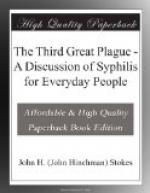Even while we concede the value of generations of experience with syphilis in determining the probable risk of infection, it is a duty to investigate thoroughly by the modern methods, such as the Wassermann blood test, the condition of all members of a family in which syphilis has appeared. This means, for example, that even though the husband with syphilis may have married years after the usual period of infectiousness has passed, his wife, though outwardly healthy, should have a Wassermann test, and his children would be none the worse for an examination, even though they seem normal. Syphilis is an insidious disease, a consummate master of deceit, able to strike from what seems a clear sky. The latest means for its recognition have already revolutionized some of our conceptions of its dangers and its transmission. It is only common prudence to take advantage of them in every case, to forestall even the remotest possibility of mistake or oversight.
Where both husband and wife have had syphilis, even though both are past the infectious stage, both should be treated, and a complete cure for the wife is advisable before they undertake to have children. This must mean an added burden of responsibility on both physician and patient, and one extremely difficult to meet under existing conditions. A reliable means of birth control used in such cases would place the problem in women on a par with that in men, and give the physician’s insistence on a complete cure for the woman a reasonable prospect of being needed. Where his advice is disregarded and a pregnancy results, the woman should be efficiently treated while she is carrying the child.
+Syphilis and Engagements to Marry.+—If a five-year rule is to be applied to marriage, a similar rule should cover the engagement of a syphilitic to marry, and it should cover the sexual relations of married people who acquire syphilis. It is not too much to expect that an engaged person who contracts syphilis shall break his engagement, and not renew it or contract another until by the five-year rule he would be able to marry with safety.




